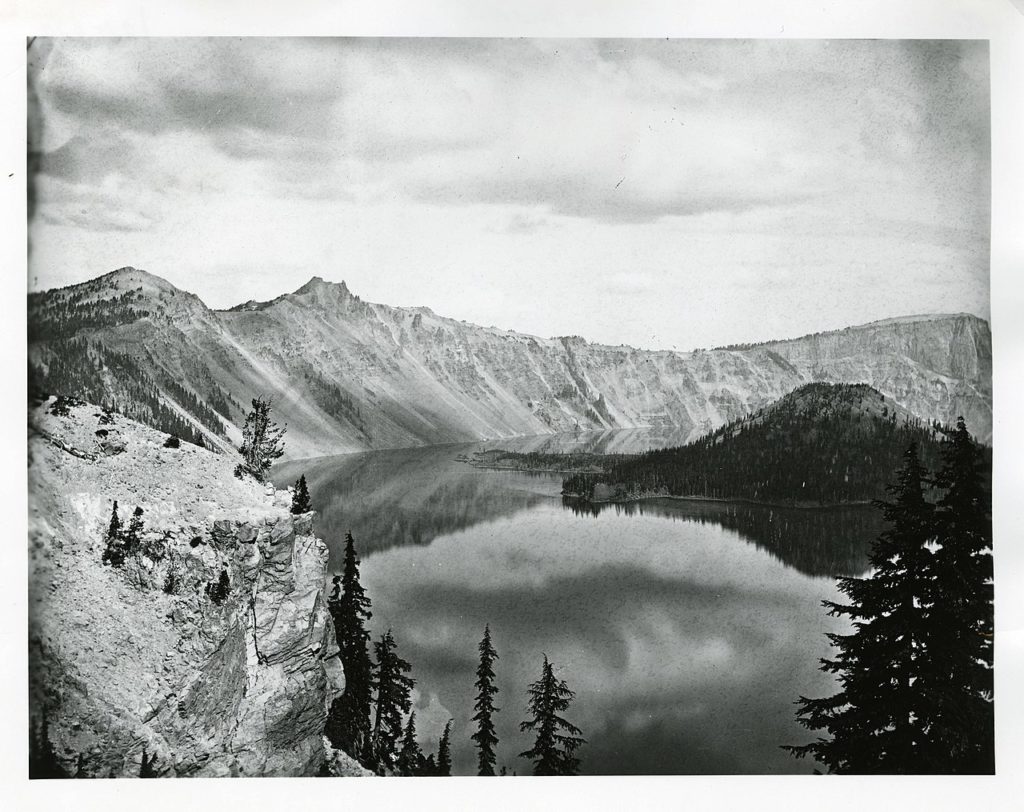
I’ve often been asked, “Why does the Pacific Northwest have so many good landscape photographers?” Well, the scenery certainly has something to offer a landscape photographer and maybe part of it is the type of person that lives in the Pacific Northwest and enjoys the lifestyle of the landscape photographer. Speaking for myself, nature photography became an extension of recording my hikes along long-distance trails.
Another reason could also be the long history and tradition of landscape photography in the area, so I’ll dabble a bit in that tradition and present a historical perspective of landscape photography in the state of Oregon. The great landscape photographer Carleton E. Watkins visited Oregon about the time Albert Bierstadt was painting Mount Hood and the Columbia River Gorge. In 1867 Watkins may have been the first person to photograph Multnomah Falls, which is one of Oregon’s earliest landscape photographs. Even though Watkins spent much of his life in California and helped preserve Yosemite, his photographs in Oregon put the state on the map for landscape photographers.
One of Oregon’s first distinguished photographers was Peter Britt. This Swiss immigrant was a man of many trades and his 1874 photograph of Crater Lake may be the first taken there. His early photographs of the lake certainly were instrumental in the preservation and creation of Crater Lake National Park. Britt also spent time photographing the Oregon coast, the coastal Redwoods, and the rivers of southern Oregon. His images can still be seen at Southern Oregon University and in the town of Jacksonville, Oregon where he lived.
The Peter Iredale shipwreck is one of those photographic icons on the Oregon coast; an ever-popular attraction for many landscape photographers. It ran aground on November 13, 1906 and Leo Simon photographed it a few days later to start a tradition.
Maybe the Oregon legacy of landscape photographers really began with Lily White. She lived in a houseboat on the Columbia River Gorge, photographing the area and contributing to the first photography club in Oregon founded in 1895. Lily White helped teach many people the art of photography through the club, and maybe her influence is why so many images were taken throughout the Gorge at the turn of the century. White may also be part of the reason Benjamin A. Gifford and his business partner Arthur M. Prentiss created so many images of the Columbia River Gorge. Prentiss photographed the Crown Point Overlook in 1914 before the Vista House was even built, and that photograph has been comp-stomped to death ever since. She may also have influenced brothers Fred and Oscar Kiser as early photographers in the Columbia River Gorge. They extensively photographed waterfalls throughout the Gorge, and Fred Kiser’s 1915 image of “Elowah Falls and McCord Creek” has influenced many photographers today who still imitate his composition, whether they know it or not.
In Oregon’s photographic history, the credit for preservation of Silver Falls State Park is often given to June Drake (1904-1960). Silver Falls State Park is a lush beautiful canyon in northwest Oregon that offers numerous views of waterfalls. When not taking portraits for his business, Drake spent much of his time visiting and photographing the landscapes of Silver Falls. After getting wind that the area was to be logged, he fought for its preservation through photography. Largely through his images and actions the area was preserved by the state in 1931.
I’d be remiss if I didn’t mention Minor White (1908-1976). He didn’t spend too much time in the state, but he began his photographic career here and photographed landscapes, portraits, and abstracts. While teaching in La Grande, Oregon, White photographed extensively in the eastern part of the state. His treatises on photography and critiques are cherished today and add to his legacy as one of the giants in the photographic world.
Ray Atkeson (1907-1990) kept the tradition of landscape photography alive in Oregon. Although he passed away almost 30 years ago, his prints and books still sell well in the state. Atkeson skied along the Oregon Cascade Range with his 4×5 camera, creating stunning black and white images of snow-covered trees and mountains. Many of his coastal images are photographic icons as is his image of Sparks Lake, where a trail is dedicated to him and one of his favorite views of the central Oregon mountains.
Oregon has a rich and storied photographic tradition and for brevities sake I’ve left many photographers out of this blog. Given the sheer numbers of photographers in the state today, I’m sure that tradition will continue and that many of the photographers today will hopefully be looked upon in the state’s history of contributing to land preservation as well as to the art of photography.

Location: Mosier, Oregon
Website: www.dmcobbphoto.com
Facebook: www.Facebook.com/DavidMCobbPhotography
Twitter: www.twitter.com/dmcobbphoto
As a long-distance hiker, I have sharpened my photographic perspective over the years on the Pacific Crest Trail, the Continental Divide, the Canadian Divide and most recently walking across Iceland. My goal is to capture the wonders I see in nature for the enjoyment of all those with an eye for the extraordinary.

Recent Comments